In my previous post on 66 Percent Sourdough Rye, I mentioned that I would be making a unique Christmas Bread using leftover bread cubes. Here it is! It’s called Hutzelbrot.
Hutzelbrot is a dense, freestanding bread served in Germany usually during Christmastime. It contains dried fruit, but no sugar. This version utilizes a mash of wheat and rye flours combined with an altus made with bread cubes from the 66 Percent Sourdough Rye bread. It also utilizes a starter made from a whole wheat or rye mother starter. I used my newly converted sourdough rye starter. It worked really well.
Another neat thing about this bread is the scoring. The bread is topped with a crunchy coating and then scored in the shape of a feather or wheat pattern. This was my first try at making Hutzelbrot so I still need to perfect the scoring, but the rice flour coating and slashes did make for a unique-looking bread. The flavor is unique as well.
Hutzelbrot with Dried Fruit
Makes:
2 Loaves
Days to Make: 2
Adapted from: Peter Reinhart’s Whole Grain Breads: New Techniques, Extraordinary Flavor
Mash:
- 10.6 oz; 300 g; or 1 1/4 cup plus 1 tablespoon water
- 2.25 oz; 64 g; or 1/2 cup whole rye meal or rye flour, preferably coarse grind
- 2.25 oz; 64 g; or 1/2 cup whole wheat flour
- .03 oz; 1 g; or 1/2 teaspoon diastatic malt powder or sprouted wheat flour (optional)
- 6 oz; 170 g altus (use all); * see Making the Altus (soaked bread)
Starter:
- 2.5 oz; 71 g; or 1/3 cup; whole wheat or rye mother starter
- 7.5 oz; 213 g; or 1 2/3 cups whole rye flour
- 6 oz; 170 g; or 3/4 cup filtered spring water, at room temperature
Final Dough:
- 16 oz; 454 g; use all of the starter
- 14 oz; 397 g; use all of the mash
- 3.5 oz; 99 g; 3/4 cup whole wheat flour
- 3.5 oz; 99 g; 3/4 cup whole rye flour
- 6 oz; 170 g; 1 cup dried fruit (citron, apricots, figs, plums, cherries, cranberries, golden raisins) I used dried cranberries.
- .5 oz; 14 g; 1 3/4 teaspoons salt
- .25 oz; 7 g; 2 1/4 teaspoons instant yeast
- .5 oz; 14 g; 1 1/2 tablespoons cocoa powder (optional)
- extra whole wheat or whole rye flour for adjustments
- Flour paste ** see Making the Flour Paste
1) Making the Altus (soaked bread):
Cover 1 cup of 1/2-inch bread cubes, crusts on, with just enough hot water to saturate and soften them, about 1/2 cup. Rye bread is preferable; however, you can substitute whole wheat. Let the altus sit at room temperature for a minimum of 4 hours, or overnight. I let it sit for 4-5 hours. You can use toasted or dried bread as well, but you will need to add more water. When you are ready to add the altus to the dough, squeeze out the excess water.
2) Creating the Mash:
Preheat the oven to 200 degrees F. Heat the water to 165 degrees F (74 degrees C) in an overproof saucepan (I used a casserole dish), then remove the pan from the heat and whisk or stir in the rye flour, whole wheat flour, and malt until the flour is fully hydrated and makes a paste similar to a thin pudding or gravy.
Using a spatula or plastic scraper dipped in water, scrape the spoon or whisk and the walls of the pan to get all of the dough back into the pan and off the inside walls. Immediately cover the pan with its lid or aluminum foil and place it in the oven.
Turn the oven down to warm/150 degrees F (66 degrees C), if it has this setting, and leave the mash in the oven for a least 1 hour and up to 3 hours. I left it in the oven for 3 hours while the altus was sitting at room temperature.
After 3 hours, stir in the soaked bread and refrigerate the mash until you are ready to use it.
Or, you can leave it out overnight at room temperature if you plan to use it within the next 24 hours. This is what I did.
3) Creating the Starter:
Mix all of the starter ingredients together in a bowl to form a ball of dough. I usually add the water to the culture first, then I mix in the rye flour.
Using wet hands, knead the dough in the bowl for about 2 minutes to be sure all of the ingredients are evenly distributed and the flour is fully hydrated. The dough should feel very tacky. Let the dough rest for about 5 minutes, then knead it again with wet hands for 1 minute. The dough will become somewhat smoother but will still be tacky.
Transfer the dough to a clean bowl, cover loosely with plastic wrap, and leave at room temperature for approximately 4 to 6 hours, until the dough is nearly double in size. The dough should have a pleasant aroma similar to apple cider vinegar. If the starter has not doubled, allow it to continue to develop at room temperature. It could take up to 8 hours or longer.
When the starter is fully developed, knead it for a few seconds to degas it. The starter is now ready for mixing into the final dough; however, if necessary to coordinate timing with the mash, cover tightly with plastic wrap and refrigerate overnight (or up to 3 days). About 2 hours before mixing the final dough, remove the starter from the refrigerator to take off the chill.
4) Mixing the Final Dough:
Using a metal pastry scraper, chop the starter into 12 smaller pieces (sprinkle some of the extra flour over the pre-dough to keep the pieces from sticking back to each other).
Put the starter pieces and mash in the bowl along with the whole wheat and rye flours, dried fruit, salt, yeast, and cocoa. Mix on slow speed for 1 minute to bring the ingredients together into a ball. Increase the speed to medium-low and continue mixing, occasionally scraping down the bowl, for 2 to 3 minutes, until the ingredients become cohesive and assimilated into each other. Add some extra flour or more water as needed until the dough is soft and slightly sticky.
Dust a work surface with flour, then roll the dough in the flour to coat. Knead the dough by hand for 3 to 4 minutes, incorporating only as much extra flour as needed, until the dough feels soft and only slightly sticky. Form the dough into a ball and let it rest on the work surface for 5 minutes.
Continue kneading the dough for 1 minute to strengthen the gluten and make any final flour or water adjustments. I added more whole wheat flour. The dough should feel soft, malleable, and very tacky but no longer sticky. Form the dough into a ball and place it in a clean oiled bowl. Roll to coat the dough with oil. Cover loosely with plastic wrap and let rise at room temperature for approximately 60 minutes, until it is at least 1 1/2 times its original size.
5) Shaping the Loaves:
Transfer the dough to a lightly floured surface and form it into 2 batards.
Begin by dividing the dough into two equal pieces (about 1.5 pounds each) and shape the pieces into boules. Cover and let them rest on the counter for 15 minutes.
Gently pat a dough ball into a rough rectangle. Fold the bottom third of dough, letter style, up to the center and press to seal, creating surface tension on the outer edge. Fold the remaining dough over the top and use the edge of your hand to seal the seam closed and to increase the surface tension all over.
Form the other loaf the same way, then transfer the batards to a parchment-lined baking sheet (or a silicon mat) and dust with rye or wheat flour.
Mist the top of the loaves with pan spray (optional) or dust with flour, cover loosely with plastic wrap or a cloth towel, and let rise at room temperature for approximately 45 to 60 minutes, until 1 1/2 times their original size.
6) Making the Flour Paste:
When the dough is ready to bake, brush it with flour paste. The flour paste is made by mixing 1 cup flour with just enough water to make a thin paste. You can use rye flour, rice flour, cornstarch, or any low-gluten flour. I used 1/2 cup of rice flour and mixed it with Spring water until it became a thin paste.
Use a pastry brush to brush the paste on the loaves.
7) Preparing the Oven for Steam Baking:
Preheat the oven to 425 degrees F. (218 degrees C) and prepare it for hearth baking by placing a baking stone on the middle rack and a steam pan underneath.
8) Scoring the Loaves:
Score the loaves in a feather, or wheat, pattern. First, use a sharp knife or blade to cut a 1/2-inch deep, horseshoe-shaped border around the top of the loaf. Next, score a 4-inch, slightly doglegged inside line with 4 feather cuts emanating off of each side.
Finally, make a deeper cut at the top end of the dogleg. For this cut, use scissors and cut straight down in order to create a deeper and wider space.
9) Baking the Loaves:
Place the loaves in the preheated oven, pour 1 cup of hot water into the steam pan, then lower the temperature to 375 degrees F. (191 degrees C), and bake for 25 minutes. Rotate the loaves 180 degrees and continue baking for another 20 to 35 minutes, until the loaves are a rich brown, sound hollow when thumped on the bottom, and register at least 200 degrees F. (93 degrees C) in the center.
10) Cooling and Slicing the Loaves:
Remove the loaves to a wire rack to cool. I let the loaves rest for 24 hours before slicing.
I really like this bread! I’ve been enjoying it with cheese. It’s a dense bread but it has a wonderful flavor.
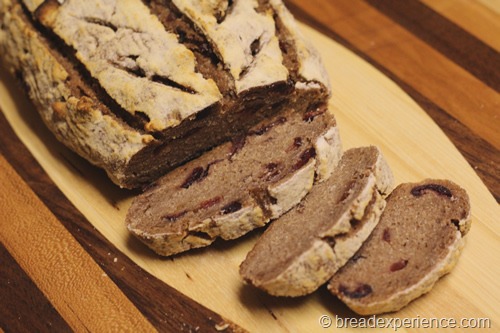 This bread has been YeastSpotted.
This bread has been YeastSpotted.
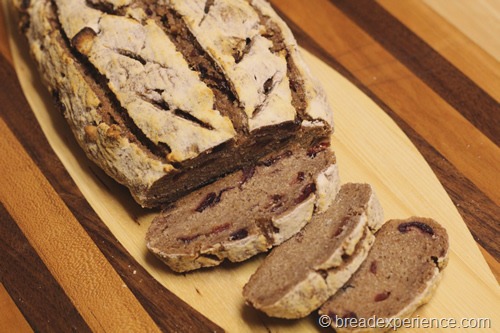
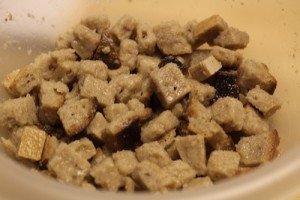
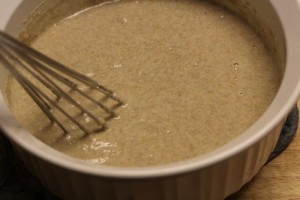
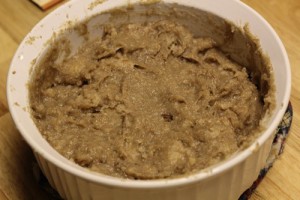
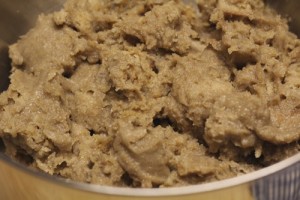
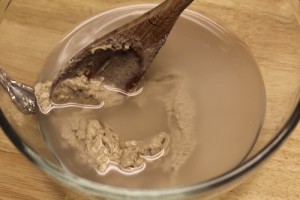
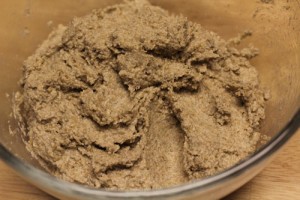
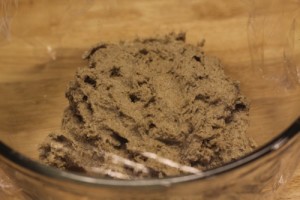
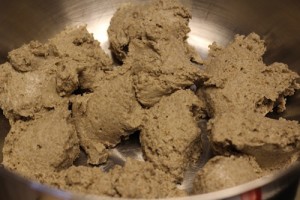
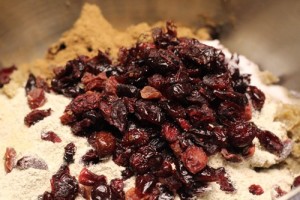
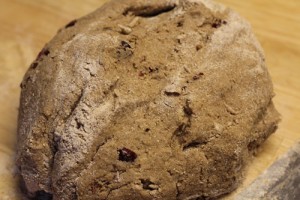
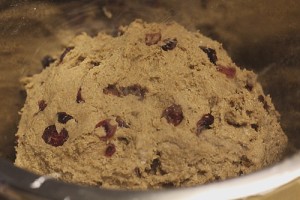
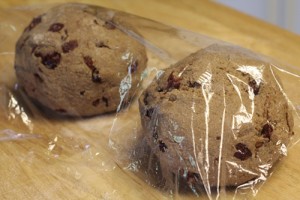
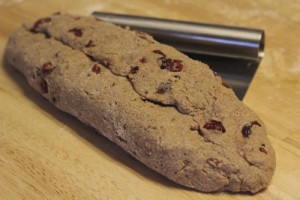
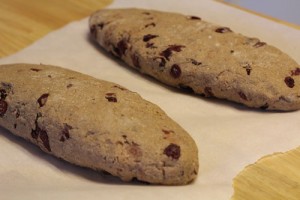
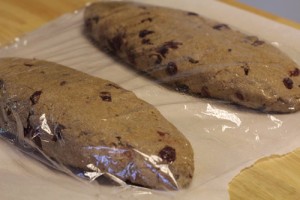
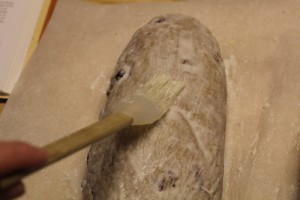
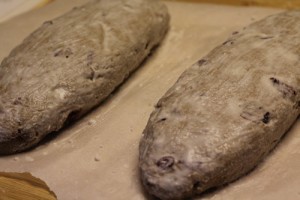
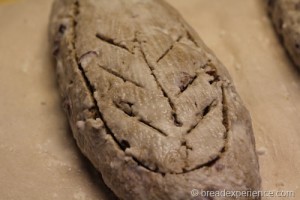
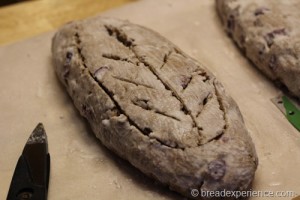
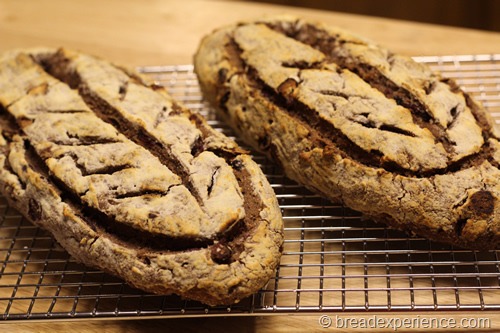
Leave a Reply